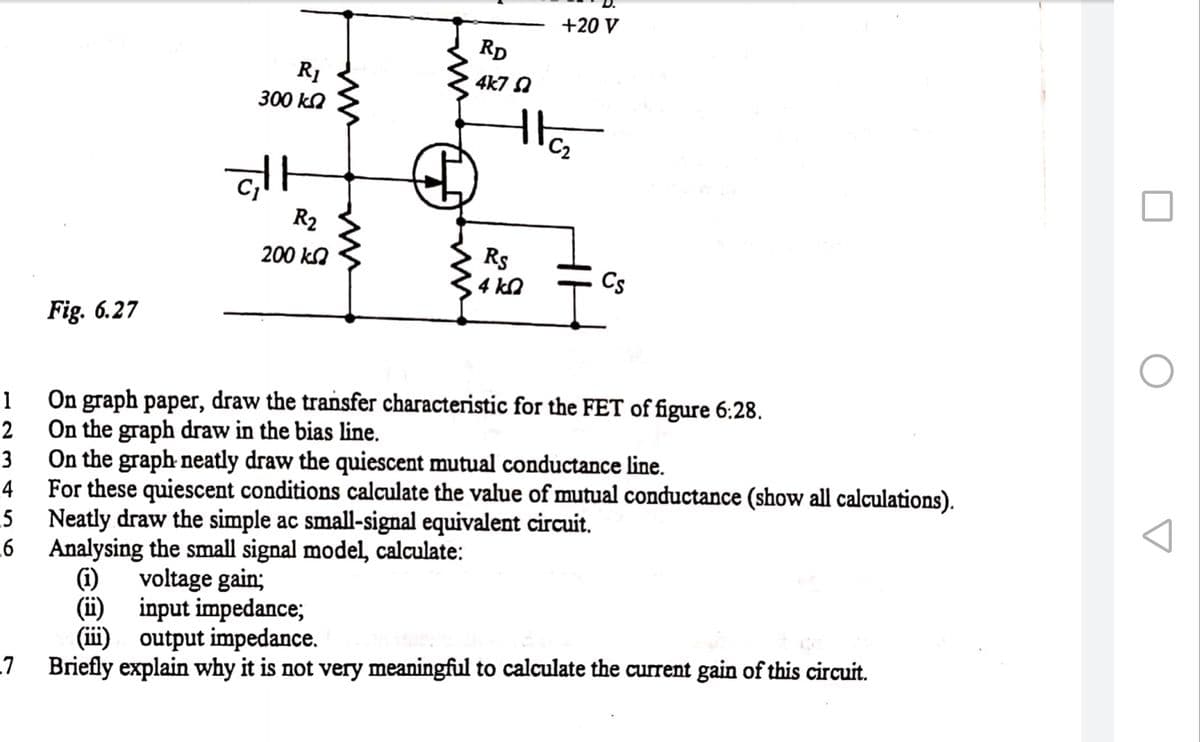+20 V RD R1 300 ka 4k7 A R2 200 ka Rs 4 kn Fig. 6.27 On graph paper, draw the transfer characteristic for the FET of figure 6:28. On the graph draw in the bias line. On the graph neatly draw the quiescent mutual conductance line. For these quiescent conditions calculate the value of mutual conductance (show all calculations). Neatly draw the simple ac small-signal equivalent circuit. 6 1 3 4 5 Analysing the small signal model, calculate: (1) (ii) (ii) voltage gain; input impedance; output impedance.
+20 V RD R1 300 ka 4k7 A R2 200 ka Rs 4 kn Fig. 6.27 On graph paper, draw the transfer characteristic for the FET of figure 6:28. On the graph draw in the bias line. On the graph neatly draw the quiescent mutual conductance line. For these quiescent conditions calculate the value of mutual conductance (show all calculations). Neatly draw the simple ac small-signal equivalent circuit. 6 1 3 4 5 Analysing the small signal model, calculate: (1) (ii) (ii) voltage gain; input impedance; output impedance.
Introductory Circuit Analysis (13th Edition)
13th Edition
ISBN:9780133923605
Author:Robert L. Boylestad
Publisher:Robert L. Boylestad
Chapter1: Introduction
Section: Chapter Questions
Problem 1P: Visit your local library (at school or home) and describe the extent to which it provides literature...
Related questions
Question
Questions 1-7

Transcribed Image Text:+20 V
RD
4k7 A
300 ko
R2
200 kO
Rs
4 kn
Cs
Fig. 6.27
On graph paper, draw the transfer characteristic for the FET of figure 6:28.
On the graph draw in the bias line.
On the graph neatly draw the quiescent mutual conductance line.
1
3
For these quiescent conditions calculate the value of mutual conductance (show all calculations).
_4
.5
Neatly draw the simple ac small-signal equivalent circuit.
Analysing the small signal model, calculate:
(i)
(i) input impedance;
(iii)
voltage gain;
output impedance.
-7 Briefly explain why it is not very meaningful to calculate the current gain of this circuit.
Expert Solution
This question has been solved!
Explore an expertly crafted, step-by-step solution for a thorough understanding of key concepts.
Step by step
Solved in 2 steps with 2 images

Knowledge Booster
Learn more about
Need a deep-dive on the concept behind this application? Look no further. Learn more about this topic, electrical-engineering and related others by exploring similar questions and additional content below.Recommended textbooks for you

Introductory Circuit Analysis (13th Edition)
Electrical Engineering
ISBN:
9780133923605
Author:
Robert L. Boylestad
Publisher:
PEARSON

Delmar's Standard Textbook Of Electricity
Electrical Engineering
ISBN:
9781337900348
Author:
Stephen L. Herman
Publisher:
Cengage Learning

Programmable Logic Controllers
Electrical Engineering
ISBN:
9780073373843
Author:
Frank D. Petruzella
Publisher:
McGraw-Hill Education

Introductory Circuit Analysis (13th Edition)
Electrical Engineering
ISBN:
9780133923605
Author:
Robert L. Boylestad
Publisher:
PEARSON

Delmar's Standard Textbook Of Electricity
Electrical Engineering
ISBN:
9781337900348
Author:
Stephen L. Herman
Publisher:
Cengage Learning

Programmable Logic Controllers
Electrical Engineering
ISBN:
9780073373843
Author:
Frank D. Petruzella
Publisher:
McGraw-Hill Education

Fundamentals of Electric Circuits
Electrical Engineering
ISBN:
9780078028229
Author:
Charles K Alexander, Matthew Sadiku
Publisher:
McGraw-Hill Education

Electric Circuits. (11th Edition)
Electrical Engineering
ISBN:
9780134746968
Author:
James W. Nilsson, Susan Riedel
Publisher:
PEARSON

Engineering Electromagnetics
Electrical Engineering
ISBN:
9780078028151
Author:
Hayt, William H. (william Hart), Jr, BUCK, John A.
Publisher:
Mcgraw-hill Education,